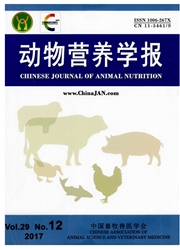

 中文摘要:
中文摘要:
本试验旨在研究以猪油或鱼油为脂肪源的饲料中添加乳化剂对牛蛙生长性能、肠道消化酶活力及肝脏生化指标的影响。试验采用2×2因子完全随机区组试验设计,2种脂肪源(猪油和鱼油)和2个乳化剂添加水平(0和300 mg/kg),配成4种等氮等能的试验饲料。将初始平均体重为(19.01±0.01) g的180只牛蛙随机分为4组,每组3个重复,每个重复15只蛙,进行为期8周的饲养试验。结果表明:未添加乳化剂的鱼油组增重率( WGR)和摄食量( FI)显著高于未添加乳化剂的猪油组( P〈0.05)。添加乳化剂的猪油组WGR和FI显著高于添加乳化剂的鱼油组( P〈0.05)。添加乳化剂的猪油组WGR、FI和特定生长率( SGR)显著高于未添加乳化剂的猪油组( P〈0.05),2组之间饲料系数( FCR)、氮沉积率( NRE)、能量沉积率( ERE)均差异不显著( P〉0.05)。添加乳化剂的鱼油组的各生长性能指标与未添加乳化剂的鱼油组均无显著差异(P〉0.05)。各组牛蛙胴体水分、粗蛋白质、粗脂肪和粗灰分含量差异不显著(P〉0.05),而添加乳化剂的猪油组全体粗脂肪含量显著高于未添加乳化剂的猪油组( P〈0.05)。各组牛蛙肠道蛋白酶和淀粉酶活力差异不显著( P〉0.05),饲料中添加乳化剂显著提高以猪油为主要脂肪源牛蛙的肠道脂肪酶活力(P〈0.05),而对以鱼油为主要脂肪源牛蛙的影响不显著(P〉0.05)。各组牛蛙肝脏过氧化氢酶( CAT)和超氧化物歧化酶( SOD)活力无显著差异( P〉0.05)。在以猪油为主要脂肪源时,添加乳化剂显著提高肝脏丙二醛( MDA)含量( P〈0.05);在以鱼油为主要脂肪源时,添加乳化剂对肝脏MDA含量无显著影响( P〉0.05)。根据结果得出,在以猪油为主要脂肪源的饲料中添加乳化剂可提高牛蛙的生长性能。
 英文摘要:
英文摘要:
The objective of this study was to investigate the effects of using lard oil or fish oil as main lipid source supplemented with emulsifier on growth performance, intestinal digestive enzyme activities and hepatic biochemical indexes of bullfrog, Rana (Lithobates) catesbeiana. A randomized complete block design with 2× 2 factors was adopted in the experiment. Four iso-nitrogenous and iso-energetic diets were formulated with diet-ary lipid source including pork lard and fish oil, and the supplemental level of emulsifier was 0 and 300 mg/kg, respectively. One hundred and eighty bullfrogs with the initial average body weight of ( 19. 01 ± 0.01) g were randomly assigned to 4 groups with 3 replicates per group and 15 bullfrogs per replicate. The ex-periment lasted for 8 weeks. The results showed that the weight gain rate ( WGR) and feed intake ( FI) of bull-frog fed with D3 ( fish oil with 0 mg/kg emulsifier ) diet were significantly higher than those fed with D1 (pork lard with 0 mg/kg emulsifier) diet (P〈0.05), whereas, the WGR and FI of bullfrog fed with D2 ( pork lard with 300 mg/kg emulsifier) diet were significantly higher than those fed with D4 ( fish oil with 300 mg/kg emulsifier) diet ( P〈0.05) . The WGR, specific growth rate ( SGR) and FI of bullfrog fed with D2 diet were significantly higher than those fed with D1 diet ( P〈0. 05 ) , however, feed conversion ratio ( FCR) , nitrogen retention rate ( NRE) , energy retention rate ( ERE) had no significant differences between two groups ( P〉0.05) . The diet using fish oil as the main lipid source with or without emulsifier had no signifi-cant effects on all growth performance indexes ( P〉0.05) . No significant difference was observed in all growth performance indexes between bullfrog fed with D3 and D4 diets (P〉0.05). There were no significant differ-ences in the contents of carcass moisture, crude protein and ash of bullfrog among all groups ( P〉0.05) , how-ever, whole-bo
 同期刊论文项目
同期刊论文项目
 同项目期刊论文
同项目期刊论文
 期刊信息
期刊信息
